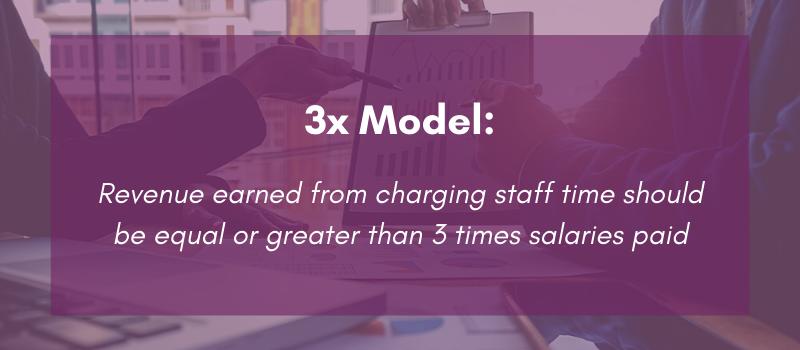A great target to improve profit in a service business is to apply the 3x model.
Put simply, the 3x model is: Revenue earned from charging staff time should be equal or greater than 3 times salaries paid.
For example if you pay salaries to staff of $450,000. Revenue earned for services provided by staff should be at least $1.35m (which is $450,000 x 3). This could be considered as the revenue ‘target’ or budget for the firm.
Here’s an example:
- Industry: IT consultancy (IT network services)
- Salary: $60,000 pa (excluding superannuation)
- Chargeable rate: $120 per hour (excluding GST)
- Hours at work pa: 52 weeks less 4 (annual leave) less 2 (public holidays) less 1 (personal) leave) x 40 hours per week = 1,800
- Productivity: 80% (meaning 20% of time at work is spent on tasks that are non billable)
The revenue equation is therefore:
Expected revenue from staff = 1,800 x 120 x 80% = $172,800
Our 3x model suggests revenue should be 3 times salary, which equals $60,000 x 3 = $180,000
The business income statement should look like this:
- Revenue (income) $3x (3 times salaries)
- Cost of Goods $1x (salaries)
- Gross Profit $2x (66.7% gross margin)
- Overheads $1x (for efficient firms)
- Net operating profit $1x (profit target)
Performance measurements using the 3x model should be done using an ‘isolationist’ approach. That is, for each period being measured (month; quarter etc.), the performance measurements should be ‘isolated’ to work completed during that period only.
The major benefit in this isolationist approach is that useful comparisons and analysis becomes possible and very useful (apples to apples).
This sounds simple enough and it is, except when the work done during the specific period is not all billed in that period. What is left is known as ‘Work in Progress’ (WIP).
In a service business, WIP is the billable hours worked up to a point in time, that have not been billed. It is an asset of the business and should be shown in the Balance Sheet. The movement in the value of WIP from one period to the next is accounted for on the Income Statement.
The ‘ageing’ of WIP should be under constant review. A client is unlikely to pay for work that was completed 12 months ago. Business who assess their performance during a period, without understanding and accounting for WIP, often become confused at the volatility of their performance.
When looking at the results of the 3x model the following questions should be asked:
- What was the revenue multiple (to salaries) for the firm as a whole?
- Which staff, were above and below the firm’s score?
- What were the reasons for differences between individuals (productivity, write offs/downs, quotation over-runs etc.)?
- What was the overheads multiple? What was the 3 month average of the overheads multiple? Which overheads were higher than expected?
- What WIP is older than 3 months and why hasn’t it been invoiced prior?
Examples of reasons for lack of performance:
Quoting inadequacies
- Not enough thought given to quotations re the actual work required to deliver.
- Lack of understanding between quote givers and service deliverers.
- Projects not ‘de-briefed’ sufficiently. Not enough ‘after-the-fact analysis’ of what transpired relative to what was expected.
- Client’s expectations from scope different to service provider’s.
Write offs/downs
- Billable tasks written off/down due to perceived lack of value provided.
- Low time tasks written off due to perceived lack of value e.g. administrative work.
Productivity
- Staff billable hours less than peers. Often due to systemic issues such as lack of defined job description.
- Expectations not clearly communicated.
Systems to handle management of the above may seem expensive, but probably cost a lot less than the extra profit from improved productivity.
If you would like to learn more about this subject, plus other useful business financial management tips, check out ‘Business Financial Toolkit’





